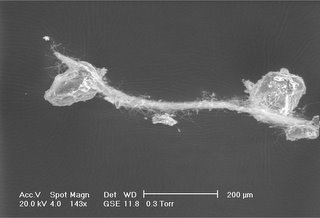
Image of tree root hair courtesy of University of Botswana
The University of Virginia and HOORC are planning a cooperative project that includes an educational component for high school students to better understand the function and carbon storage potential of root systems in savannah ecosystems.
Savannahs constitute one of the major global terrestrial carbon pools and are responsible for about 13% of global net primary productivity. They have the potential to be either large carbon sinks or large carbon sources, depending on how they are managed and the time-scale under consideration. Since southern African savannas presently have a moderate degree of anthropogenic disturbance, and since the human population is expected to rise dramatically, they have the potential to experience a significant change in carbon storage and either contribute to or alleviate the atmospheric carbon load significantly.
The Kalahari Transect (KT) follows a north-south decline in mean annual rainfall from ~1000 mm/yr to ~250 mm/yr on homogenous sandy soils deposited during the Pleistocene (Kalahari Sands). The large gradient in both the mean and variation of annual rainfall results in dramatic changes in vegetation structure along the Transect. Vegetation type ranges from partially closed woodlands in the north to open shrub land in the south. Throughout the KT, the mixed life-form composition characteristic of savannah communities is maintained. Thus, the KT is a unique natural laboratory to study landscape processes and assess the impact of global change in savannah ecosystems.
The project collaborators at the HOORC intend to explore how water and nutrients are transported via surface and deep root systems, and the role of the root system in carbon sequestration via coarse and fine root production.
For more information about the project, contact Professor Susan Ringrose at sringrose@orc.ub.bw.
No comments:
Post a Comment